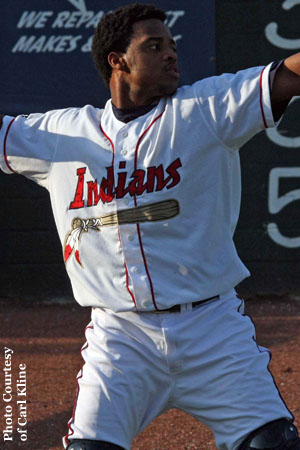
A few months ago, I decided to do a back-of-the-envelope calculation to determine which minor league hitters were above-average in three of my favorite hitting statistics: walk percentage, strikeout percentage, and isolated power. I've put aside the envelope in favor of a more formal study.
Methods
Using data from fangraphs.com, I calculated the 2008 minor league averages and standard deviations of nine commonly used hitting statistics for every full-season league.
| League | BB% | K% | IsoP | wOBA | BABIP | OBP | SLG | OPS | AVE |
| IL | 8.50% | 19.25% | .139 | .327 | .316 | .331 | .402 | .733 | .263 |
| PCL | 9.09% | 17.53% | .168 | .348 | .321 | .349 | .447 | .796 | .279 |
| East | 9.23% | 17.71% | .140 | .336 | .311 | .338 | .405 | .743 | .265 |
| Sou | 9.65% | 18.31% | .139 | .339 | .311 | .341 | .400 | .741 | .262 |
| Tex | 8.61% | 18.03% | .137 | .337 | .317 | .339 | .406 | .745 | .269 |
| Cal | 8.16% | 19.30% | .139 | .338 | .329 | .339 | .412 | .751 | .273 |
| Caro | 8.76% | 18.57% | .132 | .324 | .303 | .326 | .386 | .712 | .253 |
| FSL | 8.88% | 18.60% | .118 | .327 | .310 | .330 | .375 | .705 | .257 |
| Mid | 8.03% | 20.22% | .116 | .318 | .308 | .320 | .366 | .686 | .250 |
| SAL | 7.85% | 20.49% | .120 | .317 | .311 | .319 | .372 | .691 | .252 |
| Average | 8.68% | 18.80% | .135 | .331 | .314 | .333 | .397 | .730 | .262 |
| STDEV | 3.48% | 5.74% | .060 | .048 | .043 | .045 | .082 | .117 | .038 |
Only players with over 100 plate appearances in a league were used for my research. I ended up with 1,882 performances (roughly players) and over 500,000 minor league plate appearances. I'll work this data into future studies, but today I'm just using it to pull out some of the best all-around hitting prospects in the minors.
Ordered by wOBA, the players listed below meet the following criteria:
1a. Under the age of 24 on 7/1/09 for AAA and AA players
1b. Under the age of 23 on 7/1/09 for A+ players
1c. Under the age of 22 on 7/1/09 for Low-A players
2. At least 225 PA in one league this season
3. Better than the 2008 league average in BB%, K%, and IsoP
4. wOBA is at least a quarter of a deviation above the league average
Elite all-around hitting prospects
International League
None.
Pacific Coast League
1. Michael Saunders (LF/CF, 11/19/86): 9.7% BB, 16.7% K, .217 IsoP
Eastern League
1. Carlos Santana (C, 4/8/86): 18.9% BB, 13.2% K, .235 IsoP
Southern League
1. Desmond Jennings (CF, 10/30/86): 11.4% K, 10.3% BB, .164 IsoP
2. Zack Cozart (SS, 8/12/85): 9.7% BB, 16.2% K, .173 IsoP
3. Brandon Allen (1B, 2/12/86): 10.9% BB, 17.2% K, .162 IsoP
Texas League
1. Justin Smoak (1B, 12/5/86): 17.0% BB, 15.7% K, .156 IsoP
2. Daniel Descalso (2B, 10/19/86): 9.6% BB, 12.7% K, .208 IsoP
3. Josh Donaldson (C, 12/8/85): 15.6% BB, 17.5% K, .169 IsoP
California League
1. Thomas Neal (LF, 8/17/87): 9.6% BB, 17.9% K, .255 IsoP
2. Logan Forsythe (3B, 1/14/87): 20.1% BB, 15.8% K, .182 IsoP
3. Buster Posey (C, 3/27/87): 13.0% BB, 13.0% K, .211 IsoP
4. Jason Castro (C, 6/18/87): 11.9% BB, 16.9% K, .208 IsoP
Carolina League
1. Freddie Freeman (1B, 9/12/89): 8.8% BB, 14.1% K, .145 IsoP
Florida State League
1. Timothy Kennelly (RF, 12/5/86): 11.0% BB, 14.6% K, .141 IsoP
Midwest League
1. Brett Lawrie (2B, 1/18/90): 9.3% BB, 17.1% K, .207 IsoP
2. Kyler Burke (OF, 4/20/88): 11.8% BB, 19.2% K, .176 IsoP
South Atlantic League
1. Daniel Brewer (RF, 7/19/87): 13.7% BB, 20.3% K, .150 IsoP
Potential problems
1. It's possible that walk percentage, strikeout percentage and isolated power are not strong measures of big league potential.
2. League averages were created with only one year of data.
3. The 225 plate appearance eligibility minimum is a small sample.
4. Hitters can succeed even if they aren't above-average in each walk percentage, strikeout percentage and isolated power.
5. Age caps are a very rough way of placing value on age versus level..
5. Hitters who have split time between leagues or had injuries are missed with this study, due to the league plate appearance minimum.
6. Park factors are not considered.
Discussion
A better way to go about this kind of study could be to calculate the combined deviations above the mean for players in all three of the statistical categories. More scientific age versus level adjustments would also need to be made.
In terms of putting numbers into perspective and relying on them heavily in prospect analysis, I think more efforts like this are needed. A lot of statistical analysis is conducted absent of a relative backbone grounding the approach. If we can determine which minor league numbers correlate best with major league success, gain an understanding of typical progression through the minors, and adjust for age, park, and level, we'll have the most powerful minor league statistical analysis system available to the public. Creating this won't be easy, but it's definitely doable.
Discuss this article in our minor league forum.
